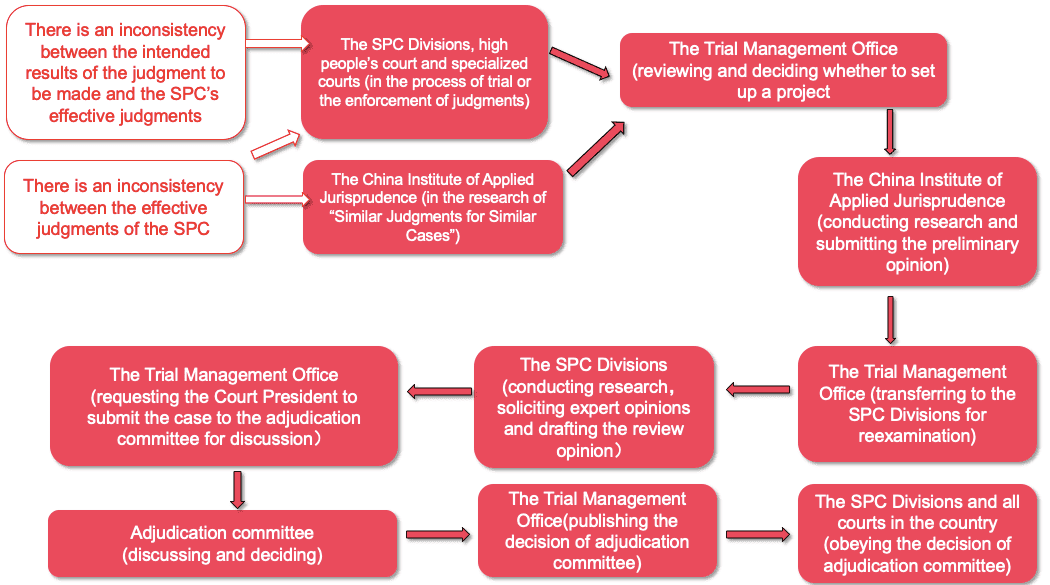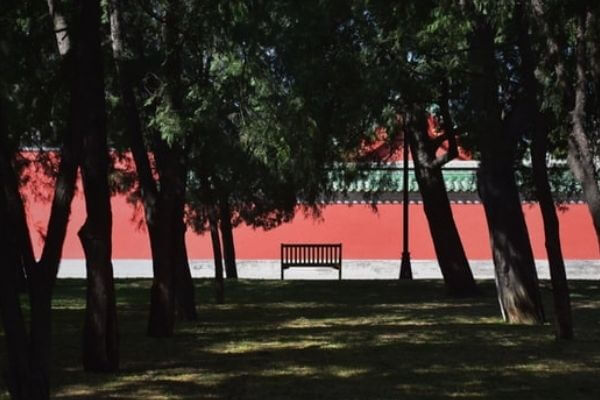
China’s Supreme People’s Court (SPC) issued a new regulation in Oct. 2019 and has since established a new procedure to avoid the inconsistency between its effective judgments in terms of the application of law.
The regulation is titled “Implementing Measures on Establishing a Mechanism to Resolve the Inconsistency in Application of Law”(《关于建立法律适用分歧解决机制的实施办法》). The SPC hopes to unify the application of law and trial standards through this new mechanism, thereby maintaining its judicial credibility.
1. What is this mechanism like?
After studying this new mechanism, I think it can be divided into four parts: discovery, management, preliminary research, and final decision. For a more detailed procedure, please refer to the flowchart below.

(1) In the part of discovering inconsistency, the case is mainly handled by the trial institutions and the research institution respectively under different circumstances.
The trial institutions include:
(a) the SPC Divisions (e.g. the Trial Divisions and Circuit Courts which undertake trial activities, and the Enforcement Department which undertakes the function of enforcing the judgments),
(b) high people’s courts of each province which constitute the lower level immediately below the SPC in the court system, and
(c) the specialized courts (e.g. intellectual property court, maritime courts, and military courts).
(For more information about the Chinese court system, you may refer to here.)
The research division refers to the China Institute of Applied Jurisprudence (中国应用法学研究所, CIAJ), a research institution directly affiliated with the SPC.
In the following situations, the trial institutions should submit an application to the SPC’s Trial Management Office to resolve the inconsistency in the application of law:
(a) There is a divergence in the application of law among the SPC’s effective judgments; or
(b) The principles or standards of the application of law applied in the intended judgments of the trial institutions may differ from the effective ones rendered by the SPC.
As the research institution, CIAJ does not hear cases, but mainly conduct legal research. Therefore, it mainly proposes an application for the aforementioned situation (1) found in its research. At present, CIAJ is conducting the research of “Similar Judgments for Similar Cases” to ensure the SPC’s judgments on similar cases in compliance with the same principles or standard of law application. The previous posts of CJO have introduced “Similar Judgments for Similar Cases”, a measure in the SPC’s judicial reform, aiming to supervise the judges and ensure the uniform application of the law.
(2) In the part of management, the SPC’s Trial Management Office is responsible for accepting the application, handing it over to the CIAJ and related divisions of the SPC to study the application, and submitting it to the adjudication committee for final discussion.
(3) In the part of research, CIAJ will conduct preliminary research of such application, and the SPC’s specific trial divisions will review the application and the study of CIAJ.
(4) In the part of final decision, the Trial Management Office will submit the reviews through the SPC’s president or vice president to the SPC’s adjudication committee for discussion and final decision.
To know more about the adjudication committee, please refer to our posts on this featured topic, or the related document issued by the SPC.
2. Why does the SPC establish such a mechanism?
As mentioned above, this mechanism is conducive for the SPC to unify the application of law and trial standards, thus maintaining its judicial credibility. But this is not the whole story.
This mechanism also interrelates a measure currently implemented by the SPC, namely, “Similar Judgments for Similar Cases”. It means that the judges’ proposed judgment must be consistent with the trial standards and law application of previous similar cases decided by the same court and its higher courts.
For more information about “Similar Judgments for Similar Cases”, please refer to our post.
The prerequisite of “Similar Judgments for Similar Cases” is that the effective judgments of similar cases are made in accordance with consistent trial standards. Otherwise, the judges will have no idea which standard they should follow.
To this end, the SPC must firstly ensure that the effective judgments of similar cases adopt consistent trial standards, and then ensure the subsequent judgments also comply with these standards. Clearly, this is exactly what this new mechanism does, setting the consistent standards and paving the way for “similar judgment for similar cases”.
Cover Image by愚木混株cdd20(https://pixabay.com/users/cdd20-1193381/) from Pixabay.
Contributors: Guodong Du 杜国栋 , Liu Qiang 刘强









